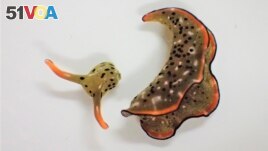14 March 2021
Scientists have discovered an extreme case of regeneration: Some sea slugs can regrow hearts and whole new bodies after having their heads cut off!
It is being called a "wonder of nature" and was recently reported in Current Biology. This discovery could help scientists better understand how to regenerate, or regrow, human tissue in the future.

This undated photo provided by Sayaka Mitoh shows a sea slug after autotomy. According to a study released in the journal Current Biology on March 8, 2021, scientists have discovered that some Japanese sea slugs can grow whole new bodies if their heads are cut off. (Sayaka Mitoh)
Biology researcher Sayaka Mitoh said she loves studying Japanese sea slugs because they are small, cute, and strange. They can even briefly photosynthesize like a plant drawing food from the sun.
Her research at Nara Women's University sounds like something from out of scary movie. While studying these small, cute creatures in the lab one day, she saw something strange. A sea slug had cut off its own head but kept on living and moving. Then a couple more sea slugs did the same!
So, Mitoh and another researcher Yoichi Yusa tried it themselves. They cut off the heads of 16 sea slugs. Six of the creatures started regeneration. Three of them survived. One of the three even lost and regrew its body twice. And two different kinds of Japanese sea slugs went through the regeneration process.
Other creatures can lose body parts when needed. For example, some lizards drop their tails to get away from danger and regrow them later. This is a biological event called autotomy.
"We think that this is the most extreme case of autotomy," Yusa said. He added that some animals can autonomize their legs or tails but no other can drop their whole body.
One kind of sea slug can grow to 15 centimeters long. Scientists had long thought that a creature that size could not survive without a heart to pump blood and nutrients to the brain.
Canadian marine biologist Susan Anthony is not part of the study. But she agreed with Yusa: the thing that makes Japanese sea slug special is probably what helps it do this trick.
When these sea slugs eat a certain type of algae, Yusa said, they can photosynthesize their food from sunlight and oxygen, just like a plant, for about 10 days. He guessed that after decapitation the head sort of acts like a plant. It turns green and gets its energy from oxygen and sunlight.
Mitoh and Yusa said that sea slugs probably developed this ability as a way of fighting off parasites.
Humans may be able to learn something useful from the sea creatures, several scientists have said. Nicholas Curtis is a biology professor at Ave Maria University. He also was not part of the study. What is especially interesting, he said, is that these sea slugs are more complex than other creatures that are known to regenerate.
In an email Curtis wrote: "It is of course a wonder of nature. But understanding the underlying molecular mechanisms involved could help us to understand how our cells and tissues can be used to repair damage."
I'm Anna Matteo.
Mayuko Ono and Seth Borenstein reported this story for The Associated Press. Anna Matteo adapted it for VOA Learning English. Hai Do was the editor.
________________________________________________________________
Words in This Story
regeneration – n.: the renewal, regrowth, or restoration of a body or a bodily part, tissue, or substance after injury or as a normal bodily process
photosynthesize – n. biology : the process by which a green plant turns water and carbon dioxide into food when the plant is exposed to light
decapitate – v. to cut off the head of (a person or animal)
autotomy – n. reflex separation of a part (such as an appendage) from the body : division of the body into two or more pieces
algae – n. any of a large group of simple plants and plant-like organisms (as a seaweed) that usually grow in water and produce chlorophyll like plants but do not produce seeds
parasite – n. an animal or plant that lives in or on another animal or plant and gets food or protection from it